In South Kona on the Big Island, there is a very special place named Pu‘uhonua o Honaunau, also called Place of Refuge. (This is a good opportunity to work on Hawaiian pronunciations—POO-OO-HO-NEW-AH O HO-NOW-NOW.) Though it can be difficult to pronounce, it is is a site of great importance, and a fun and beautiful place to explore. This ancient site is a National Historic Park and managed by the National Park Service. It’ll cost you $20 per vehicle, or $10 per person if you’re going in on foot. (If you’re also visiting Volcanoes National Park, consider getting the Annual Entrance Pass—it’ll cover entrance here and to Haleakala National Park on Maui.) Let’s dig in and learn some more about why this is a must-see on your trip to Big Island.
The History of the Place of Refuge
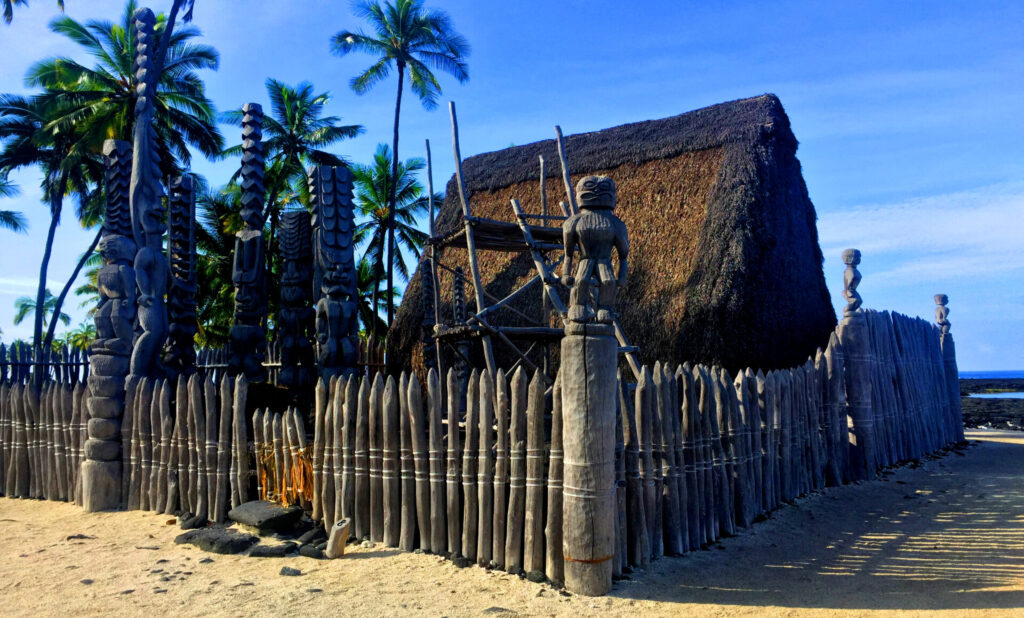 In ancient times, commoners’ lives were governed by the kapu system. There was a dizzying number of laws to observe. Those of lower classes weren’t allowed to look at or even walk on the same trails as the upper classes. Men and women were forbidden to eat together, citizens were not allowed to get close to a chief or allow their shadows to fall across them, etc. All manner of laws kept the order. The penalty for breaking any of the laws was usually the same—death by club, strangulation, fire or spear. (Hey, it’s nice to have choices, at least.) If the offense was severe enough, the offender’s entire family might be executed. It was believed that the gods retaliated against lawbreakers by sending tidal waves, lava flows, droughts and earthquakes, so communities had a great incentive to dispatch lawbreakers with haste. If a lawbreaker could elude his club or spear-wielding pursuers, however, he had one way out of his mess—the area’s pu‘uhonua (place of refuge). This pre-designated area offered asylum. If a lawbreaker could make it here, he could perform certain rituals mandated by the kahuna pule (priest). After that, all was forgiven and he could return home as if nothing had happened, regardless of the violation.
In ancient times, commoners’ lives were governed by the kapu system. There was a dizzying number of laws to observe. Those of lower classes weren’t allowed to look at or even walk on the same trails as the upper classes. Men and women were forbidden to eat together, citizens were not allowed to get close to a chief or allow their shadows to fall across them, etc. All manner of laws kept the order. The penalty for breaking any of the laws was usually the same—death by club, strangulation, fire or spear. (Hey, it’s nice to have choices, at least.) If the offense was severe enough, the offender’s entire family might be executed. It was believed that the gods retaliated against lawbreakers by sending tidal waves, lava flows, droughts and earthquakes, so communities had a great incentive to dispatch lawbreakers with haste. If a lawbreaker could elude his club or spear-wielding pursuers, however, he had one way out of his mess—the area’s pu‘uhonua (place of refuge). This pre-designated area offered asylum. If a lawbreaker could make it here, he could perform certain rituals mandated by the kahuna pule (priest). After that, all was forgiven and he could return home as if nothing had happened, regardless of the violation.
Pu‘uhonua o Honaunau Today
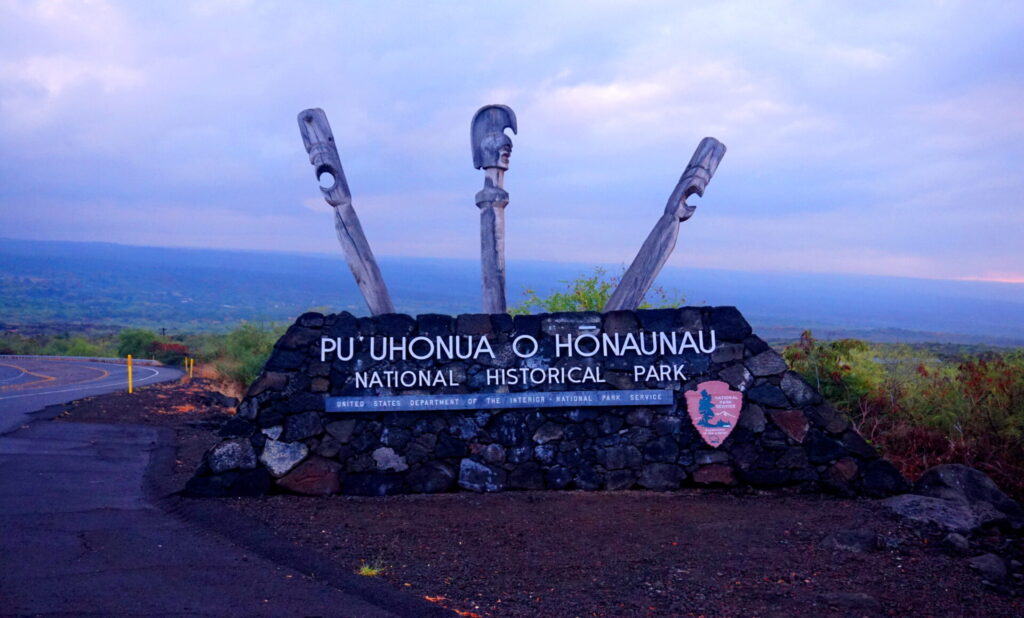 Pu‘uhonua o Honaunau is one of these above mentioned, “place of refuge”. Designated as a national park by Congress in 1961, it is the finest example of a place of refuge in all the islands. Here you will find neatly kept grounds featuring a remarkable stone wall, called the Great Wall. Built in the 1500s, this massive wall is 1,000 feet long, 10 feet high and 17 feet thick in most places. It separated the pu‘uhonua from the ali‘i’s palace grounds. Though the wall has a chiseled appearance, it was made without dressed (cut) stones and without mortar. Also on the grounds you’ll find reconstructed Hawaiian houses, temples, and a few petroglyphs (rock drawings). There are wood carvings of gods (including one that is, uh, anatomically correct, assuming that’s how the gods were endowed). The reconstructed thatched structure called Hale-o-Keawe was originally a mausoleum, containing the bones of 23 chiefs. Bones were thought to contain supernatural power, or mana, and therefore ensured that the place of refuge would remain sacred.
Pu‘uhonua o Honaunau is one of these above mentioned, “place of refuge”. Designated as a national park by Congress in 1961, it is the finest example of a place of refuge in all the islands. Here you will find neatly kept grounds featuring a remarkable stone wall, called the Great Wall. Built in the 1500s, this massive wall is 1,000 feet long, 10 feet high and 17 feet thick in most places. It separated the pu‘uhonua from the ali‘i’s palace grounds. Though the wall has a chiseled appearance, it was made without dressed (cut) stones and without mortar. Also on the grounds you’ll find reconstructed Hawaiian houses, temples, and a few petroglyphs (rock drawings). There are wood carvings of gods (including one that is, uh, anatomically correct, assuming that’s how the gods were endowed). The reconstructed thatched structure called Hale-o-Keawe was originally a mausoleum, containing the bones of 23 chiefs. Bones were thought to contain supernatural power, or mana, and therefore ensured that the place of refuge would remain sacred.
Exploring the Place of Refuge
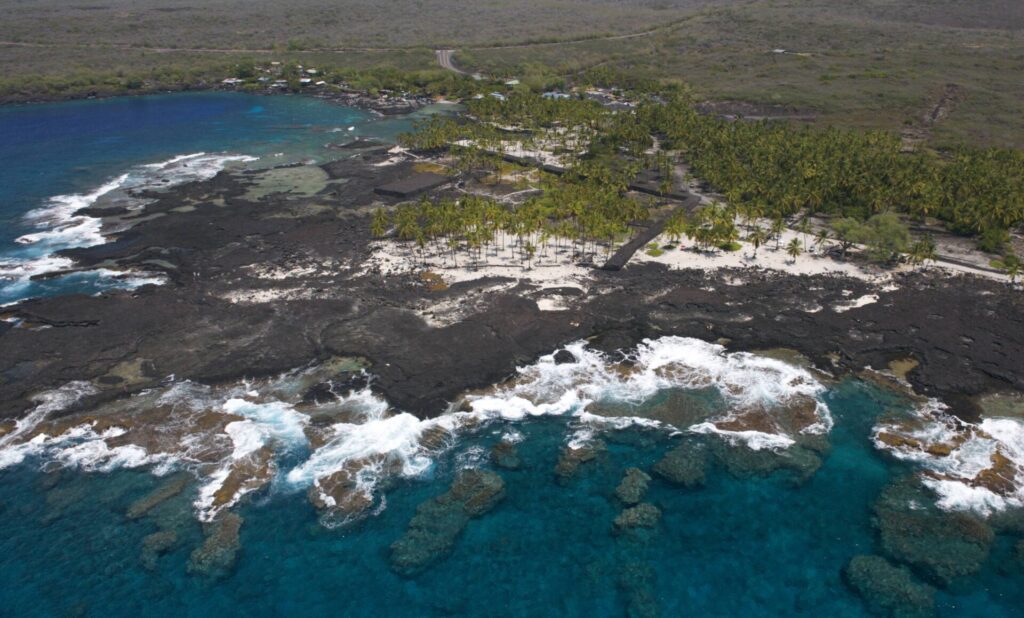 The walk around the grounds is gentle. Coconut trees (which have an almost magical, calming effect) are scattered all over. From your phone you can dial a number to listen to a guided tour around the grounds. It’ll take around 30 minutes and is pretty interesting. It’s $20 per-car to get in.
The walk around the grounds is gentle. Coconut trees (which have an almost magical, calming effect) are scattered all over. From your phone you can dial a number to listen to a guided tour around the grounds. It’ll take around 30 minutes and is pretty interesting. It’s $20 per-car to get in.
Honaunau is particularly enchanting an hour before sunset. Swaying coconut trees have a golden glow as large turtles munch limu in the water near the canoe landing. You won’t find a more relaxing or soothing place to finish off the day. Then head over to the middle/southern end of the park where picnic tables and BBQs await. Local families often bring their keiki (kids) to play in the nearby tide-pools, some of which have coral. Drive to that area using the dirt road to the left of the visitor center after you enter the park.
Activities Around the Area
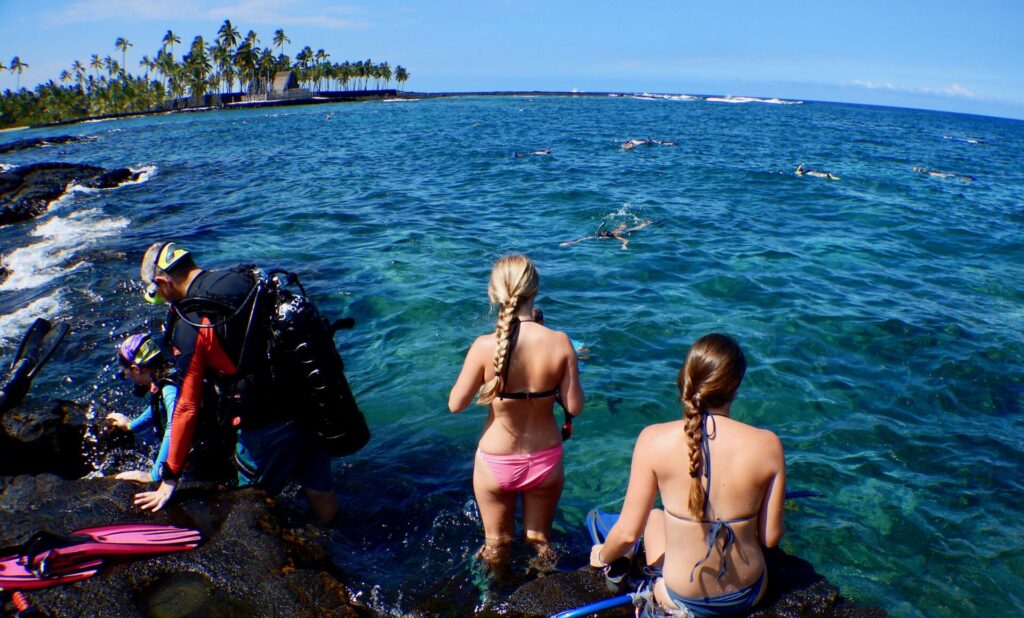 For the less cerebral, you’ll find unbeatable snorkeling and SCUBA diving in Honaunau Bay to the right of the boat launch. This area is commonly called Two-Step because of its easy entry. Perhaps even as good as the more difficult-to-reach Captain Cook Monument at Kealakekua Bay, making it some of the best in the state when conditions are good, though it’s deeper. Lots of coral. Offshore from Place of Refuge, there is a small cave where a 6-foot reef shark often rests. Don’t worry, he’s not a man-eater—yet. Very little sand here, but people lie on the hot black lava rock to warm up between rounds of snorkeling. It’s outside the park so you don’t have to pay. Parking can get full, but there are some lots that charge $5 if you’re desperate. There are also picnic tables near the shoreline at the southern half of the park that make for absolutely splendid late afternoon picnics. We’ve made good use of the BBQs there and can recommend them highly. But the park closes 15 minutes before sunset. (How thoughtful of them….) There are also hiking trails, including the 1871 Trail, so named because area residents paid their taxes in 1871 by fixing up this formerly dilapidated trail. (I have a call in to the IRS to see if the offer’s still good.) The trail goes all the way to Ho‘okena Beach, but the portion outside of the park is pretty bleak and not worth your time.
For the less cerebral, you’ll find unbeatable snorkeling and SCUBA diving in Honaunau Bay to the right of the boat launch. This area is commonly called Two-Step because of its easy entry. Perhaps even as good as the more difficult-to-reach Captain Cook Monument at Kealakekua Bay, making it some of the best in the state when conditions are good, though it’s deeper. Lots of coral. Offshore from Place of Refuge, there is a small cave where a 6-foot reef shark often rests. Don’t worry, he’s not a man-eater—yet. Very little sand here, but people lie on the hot black lava rock to warm up between rounds of snorkeling. It’s outside the park so you don’t have to pay. Parking can get full, but there are some lots that charge $5 if you’re desperate. There are also picnic tables near the shoreline at the southern half of the park that make for absolutely splendid late afternoon picnics. We’ve made good use of the BBQs there and can recommend them highly. But the park closes 15 minutes before sunset. (How thoughtful of them….) There are also hiking trails, including the 1871 Trail, so named because area residents paid their taxes in 1871 by fixing up this formerly dilapidated trail. (I have a call in to the IRS to see if the offer’s still good.) The trail goes all the way to Ho‘okena Beach, but the portion outside of the park is pretty bleak and not worth your time.
Land Tours
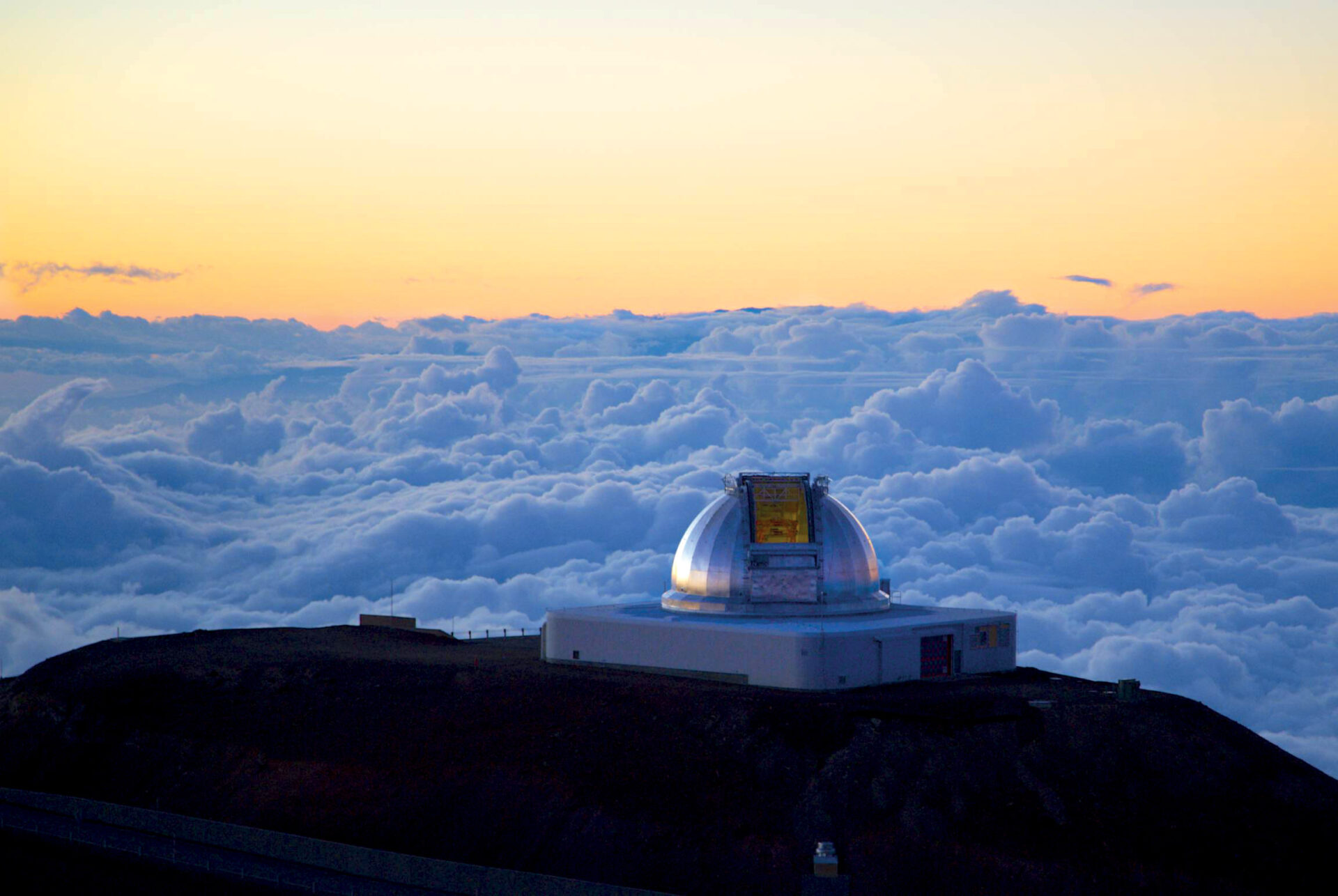
Hawaii Forest and Trail: Mauna Kea Summit and Stars
If you want a a luxurious option for stargazing on Mauna Kea without the hassle of driving, consider Hawai‘i Forest & Trail. They offer a 7.5-hour tour plus a catered dinner at a historic sheep-shearing station, a sunset visit to the summit, and stargazing with their telescope at the visitor center, complete with hot chocolate and cookies.
There’s so much more to see and experience across Hawaii. Check out our believable guides to start planning your unbelievable vacation.




0 Comments